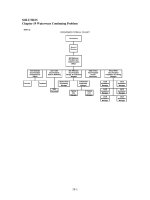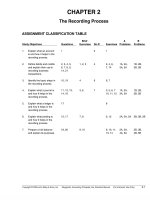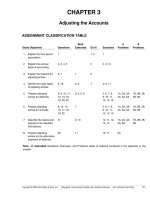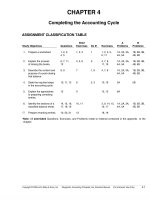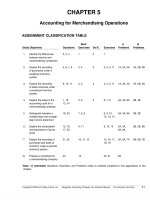Solution manual accounting principles 9e by kieso kimmel chapter 04
Bạn đang xem bản rút gọn của tài liệu. Xem và tải ngay bản đầy đủ của tài liệu tại đây (659.33 KB, 102 trang )
To download more slides, ebook, solutions and test bank, visit
CHAPTER 4
Completing the Accounting Cycle
ASSIGNMENT CLASSIFICATION TABLE
Brief
Exercises
Do It!
Exercises
A
Problems
B
Problems
1, 2, 3,
4, 5
1, 2, 3
1
1, 2, 3, 5,
6, 17
1A, 2A, 3A,
4A, 5A
1B, 2B, 3B,
4B, 5B
Explain the process
of closing the books.
6, 7, 11,
12
4, 5, 6
5
4, 7, 8,
11, 19
1A, 2A, 3A,
4A, 5A
1B, 2B, 3B,
4B, 5B
*3.
Describe the content and
purpose of a post-closing
trial balance.
8, 9
7
1, 6
4, 7, 8
1A, 2A, 3A,
4A, 5A
1B, 2B, 3B,
4B, 5B
*4.
State the required steps
in the accounting cycle.
10, 11, 12
8
2, 3
10, 19
5A
5B
*5.
Explain the approaches
to preparing correcting
entries.
13
9
12, 13
6A
*6.
Identify the sections of a
classified balance sheet.
14, 15, 16,
17, 18, 19
10, 11
3, 9, 14, 15,
16, 17
1A, 2A, 3A,
4A, 5A
*7.
Prepare reversing entries.
10, 20, 21
12
18, 19
Study Objectives
Questions
*1.
Prepare a worksheet.
*2.
1B, 2B, 3B,
4B, 5B
*Note: All asterisked Questions, Exercises, and Problems relate to material contained in the appendix *to the
chapter.
Copyright © 2009 John Wiley & Sons, Inc.
Weygandt, Accounting Principles, 9/e, Solutions Manual
(For Instructor Use Only)
4-1
To download more slides, ebook, solutions and test bank, visit
ASSIGNMENT CHARACTERISTICS TABLE
Problem
Number
Description
Difficulty
Level
Time Allotted
(min.)
Simple
40–50
1A
Prepare worksheet, financial statements, and adjusting
and closing entries.
2A
Complete worksheet; prepare financial statements,
closing entries, and post-closing trial balance.
Moderate
50–60
3A
Prepare financial statements, closing entries, and postclosing trial balance.
Moderate
40–50
4A
Complete worksheet; prepare classified balance sheet,
entries, and post-closing trial balance.
Moderate
50–60
5A
Complete all steps in accounting cycle.
Complex
70–90
6A
Analyze errors and prepare correcting entries and trial
balance.
Moderate
40–50
1B
Prepare worksheet, financial statements, and adjusting
and closing entries.
Simple
40–50
2B
Complete worksheet; prepare financial statements,
closing entries, and post-closing trial balance.
Moderate
50–60
3B
Prepare financial statements, closing entries, and postclosing trial balance.
Moderate
40–50
4B
Complete worksheet; prepare classified balance sheet,
entries, and post-closing trial balance.
Moderate
50–60
5B
Complete all steps in accounting cycle.
Complex
70–90
Comprehensive Problem: Chapters 2 to 4
4-2
Copyright © 2009 John Wiley & Sons, Inc.
Weygandt, Accounting Principles, 9/e, Solutions Manual
(For Instructor Use Only)
To download more slides, ebook, solutions and test bank, visit
WEYGANDT ACCOUNTING PRINCIPLES 9E
CHAPTER 4
COMPLETING THE ACCOUNTING CYCLE
Number
SO
BT
Difficulty
Time (min.)
BE1
1
K
Simple
2–4
BE2
1
AN
Moderate
6–8
BE3
1
C
Simple
3–5
BE4
2
AP
Simple
3–5
BE5
2
AP
Simple
4–6
BE6
2
AP
Simple
6–8
BE7
3
C
Simple
2–4
BE8
4
K
Simple
3–5
BE9
5
AN
Moderate
4–6
BE10
6
AP
Simple
4–6
BE11
6
C
Simple
3–5
BE12
7
AN
Moderate
4–6
DI1
1
C
Simple
4–6
DI2
5
AP
Simple
2–4
DI3
6
AP
Simple
6–8
DI4
6
C
Simple
4–6
EX1
1
AP
Simple
12–15
EX2
1
AP
Simple
10–12
EX3
1, 6
AP
Simple
12–15
EX4
2, 3
AP
Simple
12–15
EX5
1
AN
Simple
10–12
EX6
1
AN
Moderate
12–15
EX7
2, 3
AP
Simple
8–10
EX8
2, 3
AP
Simple
10–12
EX9
6
AP
Simple
12–15
EX10
4
C
Simple
3–5
EX11
2
AP
Simple
6–8
EX12
5
AN
Moderate
8–10
EX13
5
AN
Moderate
4–6
EX14
6
AP
Moderate
10–12
EX15
6
C
Simple
5–8
EX16
6
AP
Simple
8–10
Copyright © 2009 John Wiley & Sons, Inc.
Weygandt, Accounting Principles, 9/e, Solutions Manual
(For Instructor Use Only)
4-3
To download more slides, ebook, solutions and test bank, visit
COMPLETING THE ACCOUNTING CYCLE (Continued)
Number
SO
BT
Difficulty
Time (min.)
EX17
1, 6
AP
Simple
12–15
EX18
7
AN
Moderate
5–7
EX19
2, 4, 7
AN
Moderate
10–12
P1A
1-3, 6
AN
Simple
40–50
P2A
1-3, 6
AP
Moderate
50–60
P3A
1-3, 6
AP
Moderate
40–50
P4A
1-3, 6
AN
Moderate
50–60
P5A
1-4, 6
AN
Complex
70–90
P6A
5
AN
Moderate
40–50
P1B
1-3, 6
AN
Simple
40–50
P2B
1-3, 6
AP
Moderate
50–60
P3B
1-3, 6
AP
Moderate
40–50
P4B
1-3, 6
AN
Moderate
50–60
P5B
1-4, 6
AN
Complex
70–90
BYP1
6
AN
Simple
10–12
BYP2
6
AN
Simple
8–10
BYP3
—
E
Simple
10–12
BYP4
6
AN
Moderate
15–20
BYP5
4
C
Simple
15–20
BYP6
—
E
Moderate
10–15
BYP7
6
AP
Moderate
12–16
4-4
Copyright © 2009 John Wiley & Sons, Inc.
Weygandt, Accounting Principles, 9/e, Solutions Manual
(For Instructor Use Only)
Copyright © 2009 John Wiley & Sons, Inc.
Weygandt, Accounting Principles, 9/e, Solutions Manual
Explain the approaches to
preparing correcting entries.
Identify the sections of
a classified balance sheet.
*5.
*6.
Broadening Your Perspective
Prepare reversing entries.
State the required steps in
the accounting cycle.
*4.
*7.
Describe the content and
purpose of a post-closing trial
balance.
Explain the process of closing
the books.
*2.
*3.
Prepare a worksheet.
*1.
Study Objective
Q4-14
Q4-15
Q4-16
Q4-11
Q4-12
BE4-8
Q4-6
Q4-11
Q4-12
BE4-1
Knowledge
Communication
Q4-10
Q4-20
All About You
Q4-19
BE4-10
DI4-3
E4-3
E4-9
E4-14
Q4-17
Q4-18
BE4-11
DI4-4
E4-15
Financial Reporting
Comparative
Analysis
Decision Making
Across the
Organization
E4-18
E4-19
P4-4B
P4-5B
P4-5B
P4-5A
P4-1B
P4-4B
P4-5B
Analysis
Q4-21
BE4-12
P4-1A
P4-4A
P4-5A
P4-1B
P4-4B
P4-5B
BE4-9
E4-12
E4-13
P4-6A
DI4-2
Q4-13
E4-16
E4-17
P4-2A
P4-3A
P4-2B
P4-3B
E4-19
P4-5A
P4-5B
Q4-10
E4-10
P4-3A P4-1A
P4-2B P4-4A
P4-3B P4-5A
P4-1B
E4-4
E4-7
E4-8
P4-2A
Q4-8
Q4-9
BE4-7
E4-19
P4-1A
P4-4A
P4-5A
P4-1B
P4-4B
P4-3A BE4-2
P4-2B E4-5
P4-3B E4-6
P4-1A
P4-4A
E4-11
P4-2A
P4-3A
P4-2B
P4-3B
E4-1
E4-2
E4-3
E4-17
P4-2A
BE4-4
BE4-5
BE4-6
E4-4
E4-7
E4-8
BE4-3
DI4-1
Application
Q4-7
Q4-1
Q4-2
Q4-3
Q4-4
Q4-5
Comprehension
Synthesis
Exploring the
Web
Ethics Case
Evaluation
Correlation Chart between Bloom’s Taxonomy, Study Objectives and End-of-Chapter Exercises and Problems
To download more slides, ebook, solutions and test bank, visit
BLOOM’S TAXONOMY TABLE
(For Instructor Use Only)
4-5
To download more slides, ebook, solutions and test bank, visit
ANSWERS TO QUESTIONS
1.
No. A worksheet is not a permanent accounting record. The use of a worksheet is an optional
step in the accounting cycle.
2.
The worksheet is merely a device used to make it easier to prepare adjusting entries and the
financial statements.
3.
The amount shown in the adjusted trial balance column for an account equals the account
balance in the ledger after adjusting entries have been journalized and posted.
4.
The net income of $12,000 will appear in the income statement debit column and the balance
sheet credit column. A net loss will appear in the income statement credit column and the
balance sheet debit column.
5.
Formal financial statements are needed because the columnar data are not properly arranged
and classified for statement purposes. For example, a drawing account is listed with assets.
6.
(1)
(2)
(3)
(4)
7.
Income Summary is a temporary account that is used in the closing process. The account is
debited for expenses and credited for revenues. The difference, either net income or loss, is then
closed to the owner’s capital account.
8.
The post-closing trial balance contains only balance sheet accounts. Its purpose is to prove the
equality of the permanent account balances that are carried forward into the next accounting
period.
9.
The accounts that will not appear in the post-closing trial balance are Depreciation Expense;
Jennifer Shaeffer, Drawing; and Service Revenue.
10.
A reversing entry is the exact opposite, both in amount and in account titles, of an adjusting entry
and is made at the beginning of the new accounting period. Reversing entries are an optional
step in the accounting cycle.
11.
The steps that involve journalizing are: (1) journalize the transactions, (2) journalize the adjusting
entries, and (3) journalize the closing entries.
12.
The three trial balances are the: (1) trial balance, (2) adjusted trial balance, and (3) post-closing
trial balance.
13.
Correcting entries differ from adjusting entries because they: (1) are not a required part of the
accounting cycle, (2) may be made at any time, and (3) may affect any combination of accounts.
4-6
(Dr) Individual revenue accounts and (Cr) Income Summary.
(Dr) Income Summary and (Cr) Individual expense accounts.
(Dr) Income Summary and (Cr) Owner’s Capital (for net income).
(Dr) Owner’s Capital and (Cr) Owner’s Drawing.
Copyright © 2009 John Wiley & Sons, Inc.
Weygandt, Accounting Principles, 9/e, Solutions Manual
(For Instructor Use Only)
To download more slides, ebook, solutions and test bank, visit
Questions Chapter 4 (Continued)
*14. The standard classifications in a balance sheet are:
Assets
Current Assets
Long-term Investments
Property, Plant, and Equipment
Intangible Assets
Liabilities and Owner’s Equity
Current Liabilities
Long-term Liabilities
Owner’s Equity
*15. A company’s operating cycle is the average time required to go from cash to cash in producing
revenues. The operating cycle of a company is the average time that it takes to purchase
inventory, sell it on account, and then collect cash from customers.
*16. Current assets are assets that a company expects to convert to cash or use up in one year. Some
companies use a period longer than one year to classify assets and liabilities as current because they
have an operating cycle longer than one year. Companies usually list current assets in the order
in which they expect to convert them into cash.
*17. Long-term investments are generally investments in stocks and bonds of other companies that
are normally held for many years. Property, plant, and equipment are assets with relatively long
useful lives that a company is currently using in operating the business.
*18. (a)
(b)
The owner’s equity section for a corporation is called stockholders’ equity.
The two accounts and the purpose of each are: (1) Capital stock is used to record investments of assets in the business by the owners (stockholders). (2) Retained earnings is used
to record net income retained in the business.
*19.. PepsiCo’s current liabilities at December 29, 2007 and December 30, 2006 were $7,753 million
and $6,860 million respectively. PepsiCo’s current liabilities were significantly lower than its current
assets in both years.
*20. After reversing entries have been made, the balances will be Interest Payable, zero balance;
Interest Expense, a credit balance.
*21. (a) Jan. 10
Salaries Expense ....................................................................................
Cash................................................................................................
8,000
8,000
Because of the January 1 reversing entry that credited Salaries Expense for $3,500, Salaries
Expense will have a debit balance of $4,500 which equals the expense for the current period.
(b)
Jan. 10
Salaries Payable .....................................................................................
Salaries Expense ....................................................................................
Cash................................................................................................
3,500
4,500
8,000
Note that Salaries Expense will again have a debit balance of $4,500.
Copyright © 2009 John Wiley & Sons, Inc.
Weygandt, Accounting Principles, 9/e, Solutions Manual
(For Instructor Use Only)
4-7
To download more slides, ebook, solutions and test bank, visit
SOLUTIONS TO BRIEF EXERCISES
BRIEF EXERCISE 4-1
The steps in using a worksheet are performed in the following sequence:
(1) prepare a trial balance on the worksheet, (2) enter adjustment data,
(3) enter adjusted balances, (4) extend adjusted balances to appropriate
statement columns and (5) total the statement columns, compute net
income (loss), and complete the worksheet. Filling in the blanks, the
answers are 1, 3, 4, 5, 2.
The solution to BRIEF EXERCISE 4-2 is on page 4-9.
BRIEF EXERCISE 4-3
Account
Accumulated Depreciation
Depreciation Expense
N. Batan, Capital
N. Batan, Drawing
Service Revenue
Supplies
Accounts Payable
Income Statement
Dr.
Cr.
Balance Sheet
Dr.
Cr.
X
X
X
X
X
X
X
BRIEF EXERCISE 4-4
Dec. 31
31
31
31
4-8
Service Revenue ......................................................
Income Summary............................................
50,000
Income Summary.....................................................
Salaries Expense ............................................
Supplies Expense...........................................
31,000
Income Summary.....................................................
D. Swann, Capital............................................
19,000
D. Swann, Capital ....................................................
D. Swann, Drawing .........................................
2,000
Copyright © 2009 John Wiley & Sons, Inc.
50,000
27,000
4,000
19,000
Weygandt, Accounting Principles, 9/e, Solutions Manual
2,000
(For Instructor Use Only)
Copyright © 2009 John Wiley & Sons, Inc.
Prepaid Insurance
Service Revenue
Salaries Expense
Accounts Receivable
Salaries Payable
Insurance Expense
Account Titles
25,000
3,000
Dr.
58,000
Cr.
Trial Balance
(a) 1,200
(c)
800
(b) 1,100
Dr.
(c)
800
1,800
(a) 1,200
(b) 1,100
1,200
25,800
1,100
Dr.
800
59,100
Cr.
Adjusted
Trial Balance
Cr.
Adjustments
LEY COMPANY
Worksheet
1,200
25,800
Dr.
59,100
Cr.
Income
Statement
1,100
1,800
Dr.
800
Cr.
Balance
Sheet
To download more slides, ebook, solutions and test bank, visit
BRIEF EXERCISE 4-2
Weygandt, Accounting Principles, 9/e, Solutions Manual
(For Instructor Use Only)
4-9
To download more slides, ebook, solutions and test bank, visit
BRIEF EXERCISE 4-5
Salaries Expense
Bal. 27,000 (2) 27,000
Income Summary
(2) 31,000 (1) 50,000
(3) 19,000
50,000
50,000
Service Revenue
(1) 50,000 Bal. 50,000
Supplies Expense
Bal. 4,000 (2) 4,000
D. Swann, Capital
(4)
2,000 Bal. 30,000
(3) 19,000
Bal. 47,000
D. Swann, Drawing
Bal. 2,000 (4) 2,000
BRIEF EXERCISE 4-6
July 31
31
Date
7/31
7/31
Date
7/31
7/31
4-10
Green Fee Revenue..................................................
Income Summary.............................................
13,600
Income Summary......................................................
Salaries Expense .............................................
Maintenance Expense ....................................
10,700
Explanation
Balance
Closing entry
Green Fee Revenue
Ref.
Debit
Explanation
Balance
Closing entry
Copyright © 2009 John Wiley & Sons, Inc.
13,600
8,200
2,500
Credit
13,600
Balance
13,600
0
Credit
Balance
8,200
0
13,600
Salaries Expense
Ref.
Debit
8,200
8,200
Weygandt, Accounting Principles, 9/e, Solutions Manual
(For Instructor Use Only)
To download more slides, ebook, solutions and test bank, visit
BRIEF EXERCISE 4-6 (Continued)
Date
Explanation
7/31
7/31
Balance
Closing entry
Maintenance Expense
Ref.
Debit
Credit
Balance
2,500
2,500
0
2,500
BRIEF EXERCISE 4-7
The accounts that will appear in the post-closing trial balance are:
Accumulated Depreciation
N. Batan, Capital
Supplies
Accounts Payable
BRIEF EXERCISE 4-8
The proper sequencing of the required steps in the accounting cycle is as
follows:
1.
2.
3.
4.
5.
6.
7.
8.
9.
Analyze business transactions.
Journalize the transactions.
Post to ledger accounts.
Prepare a trial balance.
Journalize and post adjusting entries.
Prepare an adjusted trial balance.
Prepare financial statements.
Journalize and post closing entries.
Prepare a post-closing trial balance.
Filling in the blanks, the answers are 4, 2, 8, 7, 5, 3, 9, 6, 1.
Copyright © 2009 John Wiley & Sons, Inc.
Weygandt, Accounting Principles, 9/e, Solutions Manual
(For Instructor Use Only)
4-11
To download more slides, ebook, solutions and test bank, visit
BRIEF EXERCISE 4-9
1.
2.
Service Revenue .............................................................................
Accounts Receivable............................................................
780
Accounts Payable ($1,750 – $1,570).........................................
Store Supplies ........................................................................
180
780
180
BRIEF EXERCISE 4-10
DIAZ COMPANY
Partial Balance Sheet
Current assets
Cash .........................................................................................................
Short-term investments.....................................................................
Accounts receivable ...........................................................................
Supplies ..................................................................................................
Prepaid insurance ...............................................................................
Total current assets ...................................................................
$15,400
6,700
12,500
5,200
3,600
$43,400
BRIEF EXERCISE 4-11
CL
CA
PPE
PPE
CA
IA
Accounts payable
Accounts receivable
Accumulated depreciation
Building
Cash
Copyrights
CL
LTI
PPE
CA
IA
CA
Income tax payable
Investment in long-term bonds
Land
Merchandise inventory
Patent
Supplies
*BRIEF EXERCISE 4-12
Nov. 1
Salaries Payable.................................................................... 1,400
Salaries Expense .........................................................
1,400
The balances after posting the reversing entry are Salaries Expense (Cr.)
$1,400 and Salaries Payable $0.
4-12
Copyright © 2009 John Wiley & Sons, Inc.
Weygandt, Accounting Principles, 9/e, Solutions Manual
(For Instructor Use Only)
To download more slides, ebook, solutions and test bank, visit
SOLUTIONS FOR DO IT! REVIEW EXERCISES
DO IT! 4-1
Income statement debit column—Utilities Expense
Income statement credit column—Service Revenue
Balance sheet debit column—Accounts Receivable
Balance sheet credit column—Notes Payable; Accumulated Depreciation;
V. Klitschko, Capital
DO IT! 4-2
Dec. 31
Dec. 31
Income Summary ................................................
J. Q. Adams, Capital ...................................
29,000
J. Q. Adams, Capital...........................................
J. Q. Adams, Drawing.................................
22,000
29,000
22,000
DO IT! 4-3
VASQUEZ COMPANY
Partial Balance Sheet
Current assets
Cash ...................................................................................
Short-term investments...............................................
Accounts receivable .....................................................
Inventories .......................................................................
Total current assets...............................................
Long-term investments
Investments in stock ....................................................
Property, plant and equipment
Equipment........................................................................
Less: Accumulated depreciation ............................
Total assets ..............................................................................
Copyright © 2009 John Wiley & Sons, Inc.
Weygandt, Accounting Principles, 9/e, Solutions Manual
$13,400
120
4,300
2,900
$20,720
6,500
21,700
5,700
16,000
$43,220
(For Instructor Use Only)
4-13
To download more slides, ebook, solutions and test bank, visit
DO IT! 4-4
NA
CL
CL
CA
LTL
IA
4-14
Interest revenue
Utilities payable
Accounts payable
Supplies
Bonds Payable
Trademarks
Copyright © 2009 John Wiley & Sons, Inc.
OE
PPE
PPE
NA
LTI
CL
J. Crofoot, Capital
Accumulated depreciation
Machinery
Salaries expense
Investment in real estate
Unearned rent
Weygandt, Accounting Principles, 9/e, Solutions Manual
(For Instructor Use Only)
To download more slides, ebook, solutions and test bank, visit
SOLUTIONS TO EXERCISES
EXERCISE 4-1
BRISCOE COMPANY
Worksheet
For the Month Ended June 30, 2010
Account Titles
Cash
Trial Balance
Adjustments
Dr.
Dr.
Cr.
Cr.
Adj. Trial Balance
Dr.
Cr.
Income Statement
Dr.
Cr.
Balance Sheet
Dr.
2,320
2,320
2,320
2,440
2,440
2,440
Cr.
Accounts
Receivable
Supplies
1,880
Accounts Payable
(a) 1,580
300
1,120
Unearned Revenue
240 (b)
140
300
1,120
1,120
100
100
Lenny Briscoe,
3,600
Capital
Service Revenue
Salaries Expense
3,600
2,400
560
(b)
(c)
140
280
3,600
2,540
2,540
840
840
160
160
Miscellaneous
Expense
Totals
160
7,360
7,360
Supplies Expense
(a) 1,580
Salaries Payable
Totals
1,580
(c)
2,000
280
2,000
1,580
280
7,640
7,640
280
2,580
Net Loss
Totals
Copyright © 2009 John Wiley & Sons, Inc.
2,580
Weygandt, Accounting Principles, 9/e, Solutions Manual
2,540
5,060
40
40
2,580
5,100
(For Instructor Use Only)
5,100
5,100
4-15
To download more slides, ebook, solutions and test bank, visit
EXERCISE 4-2
GOODE COMPANY
(Partial) Worksheet
For the Month Ended April 30, 2010
Adjusted
Trial Balance
Account Titles
Cash
Accounts Receivable
Prepaid Rent
Equipment
Accum. Depreciation
Notes Payable
Accounts Payable
T. Goode, Capital
T. Goode, Drawing
Service Revenue
Salaries Expense
Rent Expense
Depreciation Expense
Interest Expense
Interest Payable
Totals
Net Income
Totals
4-16
Dr.
13,752
7,840
2,280
23,050
Cr.
Income
Statement
Dr.
Cr.
Balance Sheet
Dr.
13,752
7,840
2,280
23,050
4,921
5,700
5,672
30,960
4,921
5,700
5,672
30,960
3,650
3,650
15,590
10,840
760
671
57
62,900
Copyright © 2009 John Wiley & Sons, Inc.
Cr.
15,590
10,840
760
671
57
57
62,900
12,328
3,262
15,590
15,590
50,572
15,590
50,572
Weygandt, Accounting Principles, 9/e, Solutions Manual
57
47,310
3,262
50,572
(For Instructor Use Only)
To download more slides, ebook, solutions and test bank, visit
EXERCISE 4-3
GOODE COMPANY
Income Statement
For the Month Ended April 30, 2010
Revenues
Service revenue..................................................................
Expenses
Salaries expense................................................................
Rent expense ......................................................................
Depreciation expense.......................................................
Interest expense.................................................................
Total expenses...........................................................
Net income ....................................................................................
$15,590
$10,840
760
671
57
12,328
$ 3,262
GOODE COMPANY
Owner’s Equity Statement
For the Month Ended April 30, 2010
T. Goode, Capital, April 1 ....................................................................
Add: Net income ..................................................................................
Less: Drawings......................................................................................
T. Goode, Capital, April 30..................................................................
$30,960
3,262
34,222
3,650
$30,572
GOODE COMPANY
Balance Sheet
April 30, 2010
Assets
Current assets
Cash .......................................................................................
Accounts receivable .........................................................
Prepaid rent .........................................................................
Total current assets .................................................
Property, plant, and equipment
Equipment ............................................................................
Less: Accumulated depreciation.................................
Total assets.................................................................
Copyright © 2009 John Wiley & Sons, Inc.
Weygandt, Accounting Principles, 9/e, Solutions Manual
$13,752
7,840
2,280
$23,872
23,050
4,921
18,129
$42,001
(For Instructor Use Only)
4-17
To download more slides, ebook, solutions and test bank, visit
EXERCISE 4-3 (Continued)
GOODE COMPANY
Balance Sheet (Continued)
April 30, 2010
Liabilities and Owner’s Equity
Current liabilities
Notes payable .....................................................................
Accounts payable..............................................................
Interest payable..................................................................
Total current liabilities ............................................
Owner’s equity
T. Goode, Capital ...............................................................
Total liabilities and owner’s equity.....................
$5,700
5,672
57
$11,429
30,572
$42,001
EXERCISE 4-4
(a) Apr. 30
30
30
30
Service Revenue..............................................
Income Summary....................................
15,590
Income Summary.............................................
Salaries Expense ....................................
Rent Expense...........................................
Depreciation Expense...........................
Interest Expense .....................................
12,328
Income Summary.............................................
T. Goode, Capital ....................................
3,262
T. Goode, Capital .............................................
T. Goode, Drawing..................................
3,650
15,590
10,840
760
671
57
3,262
3,650
(b)
(2)
(3)
4-18
Income Summary
12,328 (1)
15,590
3,262
15,590
15,590
Copyright © 2009 John Wiley & Sons, Inc.
(4)
T. Goode, Capital
3,650 Bal.
30,960
(3)
3,262
Bal.
30,572
Weygandt, Accounting Principles, 9/e, Solutions Manual
(For Instructor Use Only)
To download more slides, ebook, solutions and test bank, visit
EXERCISE 4-4 (Continued)
(c)
GOODE COMPANY
Post-Closing Trial Balance
April 30, 2010
Cash ................................................................................
Accounts Receivable.................................................
Prepaid Rent.................................................................
Equipment .....................................................................
Accumulated Depreciation ......................................
Notes Payable ..............................................................
Accounts Payable.......................................................
Interest Payable...........................................................
T. Goode, Capital ........................................................
Debit
$13,752
7,840
2,280
23,050
$46,922
Credit
$ 4,921
5,700
5,672
57
30,572
$46,922
EXERCISE 4-5
(a) Accounts Receivable.................................................
Service Revenue .................................................
600
Insurance Expense.....................................................
Prepaid Insurance..............................................
400
Depreciation Expense ................................................
Accumulated Depreciation .............................
900
Salaries Expense .........................................................
Salaries Payable..................................................
500
Copyright © 2009 John Wiley & Sons, Inc.
Weygandt, Accounting Principles, 9/e, Solutions Manual
600
400
900
500
(For Instructor Use Only)
4-19
To download more slides, ebook, solutions and test bank, visit
EXERCISE 4-5 (Continued)
(b)
Income Statement
Dr.
Accounts Receivable
Prepaid Insurance
Accum. Depreciation
Salaries Payable
Service Revenue
Salaries Expense
Insurance Expense
Depreciation Expense
Cr.
Balance Sheet
Dr.
X
X
Cr.
X
X
X
X
X
X
EXERCISE 4-6
(a) Accounts Receivable—$25,000 ($34,000 – $9,000).
Supplies—$2,000 ($7,000 – $5,000).
Accumulated Depreciation—$22,000 ($12,000 + $10,000).
Salaries Payable—$0 No liability recorded until adjustments are made.
Insurance Expense—$6,000 ($26,000 – $20,000).
Salaries Expense—$44,000 ($49,000 – $5,000).
(b) Accounts Receivable..........................................................
Service Revenue .........................................................
9,000
Insurance Expense..............................................................
Prepaid Insurance ......................................................
6,000
Supplies Expense................................................................
Supplies .........................................................................
5,000
Depreciation Expense ........................................................
Accumulated Depreciation ......................................
10,000
Salaries Expense .................................................................
Salaries Payable..........................................................
5,000
4-20
Copyright © 2009 John Wiley & Sons, Inc.
9,000
6,000
5,000
10,000
Weygandt, Accounting Principles, 9/e, Solutions Manual
5,000
(For Instructor Use Only)
To download more slides, ebook, solutions and test bank, visit
EXERCISE 4-7
(a) Service Revenue .............................................................
Income Summary.....................................................
4,064
Income Summary............................................................
Salaries Expense .....................................................
Miscellaneous Expense.........................................
Supplies Expense....................................................
3,828
Income Summary............................................................
Emil Skoda, Capital.................................................
236
Emil Skoda, Capital........................................................
Emil Skoda, Drawing ..............................................
300
(b)
4,064
1,344
256
2,228
236
300
EMIL SKODA COMPANY
Post-Closing Trial Balance
For the Month Ended June 30, 2010
Account Titles
Cash ....................................................................................
Accounts Receivable.....................................................
Supplies .............................................................................
Accounts Payable...........................................................
Salaries Payable..............................................................
Unearned Revenue.........................................................
Emil Skoda, Capital........................................................
Debit
$3,712
3,904
480
$8,096
Copyright © 2009 John Wiley & Sons, Inc.
Weygandt, Accounting Principles, 9/e, Solutions Manual
Credit
$1,792
448
160
5,696
$8,096
(For Instructor Use Only)
4-21
To download more slides, ebook, solutions and test bank, visit
EXERCISE 4-8
(a)
General Journal
Date
Account Titles
July 31 Commission Revenue..............................
Rent Revenue .............................................
Income Summary............................
Ref.
404
429
350
Debit
65,000
6,500
31 Income Summary.......................................
Salaries Expense ............................
Utilities Expense .............................
Depreciation Expense ...................
350
720
732
711
74,600
31 B. J. Apachi, Capital .................................
Income Summary............................
301
350
3,100
31 B. J. Apachi, Capital .................................
B. J. Apachi, Drawing....................
301
306
16,000
J15
Credit
71,500
55,700
14,900
4,000
3,100
16,000
(b)
B. J. Apachi, Capital
Date
Explanation
Ref.
Debit
July 31 Balance
31 Close net loss
J15
3,100
31 Close drawing
J15
16,000
Income Summary
Date
Explanation
Ref.
Debit
July 31 Close revenue
J15
31 Close expenses
J15
74,600
31 Close net loss
J15
4-22
Copyright © 2009 John Wiley & Sons, Inc.
Credit
Credit
71,500
3,100
Weygandt, Accounting Principles, 9/e, Solutions Manual
No. 301
Balance
45,200
42,100
26,100
No. 350
Balance
71,500
(3,100)
0
(For Instructor Use Only)
To download more slides, ebook, solutions and test bank, visit
EXERCISE 4-8 (Continued)
(c)
APACHI COMPANY
Post-Closing Trial Balance
July 31, 2010
Cash ................................................................................
Accounts Receivable.................................................
Equipment .....................................................................
Accumulated Depreciation ......................................
Accounts Payable.......................................................
Unearned Rent Revenue...........................................
B. J. Apachi, Capital...................................................
Debit
$14,840
8,780
15,900
$39,520
Credit
$ 7,400
4,220
1,800
26,100
$39,520
EXERCISE 4-9
(a)
APACHI COMPANY
Income Statement
For the Year Ended July 31, 2010
Revenues
Commission revenue........................................
Rent revenue .......................................................
Total revenues ...........................................
Expenses
Salaries expense................................................
Utilities expense.................................................
Depreciation expense.......................................
Total expenses...........................................
Net loss ..........................................................................
Copyright © 2009 John Wiley & Sons, Inc.
Weygandt, Accounting Principles, 9/e, Solutions Manual
$65,000
6,500
$71,500
55,700
14,900
4,000
74,600
($ 3,100)
(For Instructor Use Only)
4-23
To download more slides, ebook, solutions and test bank, visit
EXERCISE 4-9 (Continued)
APACHI COMPANY
Owner’s Equity Statement
For the Year Ended July 31, 2010
B. J. Apachi, Capital, August 1, 2009...................
Less: Net loss .............................................................
Drawings ..........................................................
B. J. Apachi, Capital, July 31, 2010.......................
(b)
$45,200
$ 3,100
16,000
19,100
$26,100
APACHI COMPANY
Balance Sheet
July 31, 2010
Assets
Current assets
Cash ..........................................................................
Accounts receivable ............................................
Total current assets ....................................
Property, plant, and equipment
Equipment...............................................................
Less: Accumulated depreciation ...................
Total assets ...................................................
$14,840
8,780
$23,620
15,900
7,400
8,500
$32,120
Liabilities and Owner’s Equity
Current liabilities
Accounts payable.................................................
Unearned rent revenue .......................................
Total current liabilities ...............................
Owner’s equity
B. J. Apachi, Capital ............................................
Total liabilities and owner’s equity........
4-24
Copyright © 2009 John Wiley & Sons, Inc.
$4,220
1,800
Weygandt, Accounting Principles, 9/e, Solutions Manual
$ 6,020
26,100
$32,120
(For Instructor Use Only)
To download more slides, ebook, solutions and test bank, visit
EXERCISE 4-10
1.
False “Analyze business transactions” is the first step in the accounting
cycle.
2.
False. Reversing entries are an optional step in the accounting cycle.
3.
True.
4.
True.
5.
True.
6.
False. Steps 1–3 may occur daily in the accounting cycle. Steps 4–7 are
performed on a periodic basis. Steps 8 and 9 are usually prepared only
at the end of a company’s annual accounting period.
7.
False. The step of “journalize the transactions” occurs before the step
of “post to the ledger accounts.”
8.
False. Closing entries are prepared after financial statements are prepared.
EXERCISE 4-11
(a) June 30
30
30
30
Service Revenue...........................................
Income Summary ................................
15,100
Income Summary .........................................
Salaries Expense.................................
Supplies Expense ...............................
Rent Expense .......................................
13,100
Income Summary .........................................
Nina Cole, Capital................................
2,000
Nina Cole, Capital ........................................
Nina Cole, Drawing .............................
2,500
15,100
8,800
1,300
3,000
2,000
2,500
(b)
Income Summary
June 30 13,100 June 30
June 30
2,000
15,100
Copyright © 2009 John Wiley & Sons, Inc.
15,100
15,100
Weygandt, Accounting Principles, 9/e, Solutions Manual
(For Instructor Use Only)
4-25
